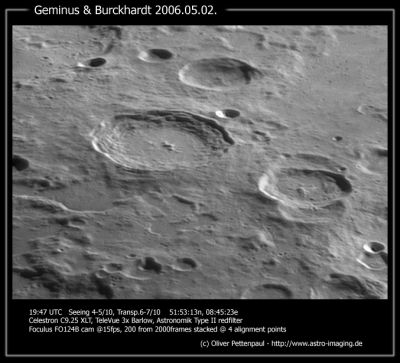Geminus
Contents
[hide]Geminus
|
Lat: 34.5°N, Long: 56.7°E, Diam: 85 km, Depth: 4.76 km, Rükl: 16 |

Oliver Pettenpaul Geminus is the crater just to the left of center in this view with north to the left. Behind it, to its upper right (east) is the 47 km Bernoulli, and to Geminus' lower right (south) is 56 km Burckhardt. A small piece of the large crater Cleomedes is just visible in the extreme lower right (with Debes and Tralles on the lower right margin), and of Messala in the upper left. The IAU's Geminus A is the undistinguished little 15 km crater at bottom, on the centerline; with the slightly larger and more irregular Geminus F to its left.
Images
LPOD Photo Gallery Lunar Orbiter Images Apollo Images
Maps
(LAC zone 27C3) LAC map Geologic map
Description
Description: Elger
(IAU Directions) GEMINUS.--A fine regular ring-plain, 54 miles in diameter, nearly circular, with bright walls, rising on the W. to a height of more than 12,000 feet, and on the opposite side to nearly 16,000 feet above the floor. Their crest is everywhere very steep, and the inner slope is much terraced. There is a small but conspicuous mountain in the interior; N. of which I have seen a long ridge, where Schmidt shows some hillocks. Two fine clefts are easily visible within the ring, one running for some distance on the S.W. side of the floor, mounting the inner slope of the S.E. border to the summit ridge (where it is apparently interrupted), and then striking across the plain in a S.E. direction. Here it is accompanied for a short distance by a somewhat coarser companion, running parallel to it on the N. The other cleft occupies a very similar position on the N.E. side of the floor at the inner foot of the wall. On several occasions, when observing this formation and the vicinity, I have been struck by its peculiar colour under a low evening sun. At this time the whole region appears to be of a warm light brown or sepia tone.
Sepia
The last bit of Elger's description of Geminus is a very interesting one (the peculiar warm light brownish or sepia-ish coloration), because this seems to be a frequent phenomenon whenever certain regions near the moon's eastern limb are observed during Waning Gibbous Moon, when the evening terminator runs along these regions.- DannyCaes Nov 2, 2012
See also Walter Goodacre's observation of a brownish coloration at Atlas during local evening light.- DannyCaes Nov 2, 2012
Is there an equivalent of the same kind of phenomenon at western limb regions during Waxing Gibbous Moon? (near Full Moon); for example Harold Hill's observation of a reddish coloration near Lichtenberg, and Richard Baum's observation of the same sort of reddish coloration near Philolaus. Each one of those observations happened about two days before Full Moon.- DannyCaes Jul 27, 2013
Description: Wikipedia
Additional Information
- Depth data from Kurt Fisher database
Westfall, 2000: 4.76 km
Viscardy, 1985: 5.4 km
Cherrington, 1969: 2.86 km - TSI = 35, CPI = 25, FI = 25; MI =85 Smith and Sanchez, 1973
- Central Peak Height: Main peak = 1.1 km (1085 m approx., -- calculated from shadows in LO Frame 4191 H2 using LTVT) - JohnMoore2 . By the LRO altimetry tool, the height is 900 m - Nunki
Nomenclature
- Named for Geminus of Rhodes (ca.110 - 40 BCE), a Greek astronomer and mathematician. During his career he wrote introductory works in mathematics and astronomy, and is typically credited with the construction of the Antikythera mechanism. His astronomical observations noted that the length of a day varied in different parts of the world.
- Secondary crater Geminus A was called Athinagoras by Felix Chemla Lamech, but the I.A.U. did not accept this name. Research : Ewen A. Whitaker and Danny Caes (August 2003 mail correspondence, thanks to Jenny Blue of the USGS-IAU).
- From the title image, the IAU's Geminus A seems a strange choice for naming. Perhaps Lamèch had a different Geminus A in mind? - JimMosher
Promontorium Archidaeum
- A mountainous region between Geminus and nearby Berzelius was once called Promontorium Archidaeum by William Radcliffe Birt.
- See: Lunar Objects Suitable for Observation in June 1872 (W.R.Birt).
LPOD Articles
Bibliography
Felix Chemla Lamech's Athinagoras and William Radcliffe Birt's Promontorium Archidaeum: Ewen A. Whitaker's Mapping and Naming the Moon.
W.R. Birt (1858) On Successive Illuminations of the Lunar crater Geminus.